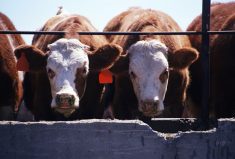Compared to last week, western Canadian yearling markets traded $2-$3 on either side of unchanged. Calf prices were mostly unchanged compared to seven days earlier; however, there were pockets where buyers reported prices up $2-$3 on average. The Alberta calf market appeared to stage a minor recovery after softening over the past month. Manitoba markets were steady to $2 higher. Strength in deferred live cattle futures along with a softer barley market set a positive tone. A resurgence of demand from southern Alberta feedlots appeared to spark a domino effect across the Prairies while Ontario buyers were keen to secure ownership in Manitoba.
Read Also

U.S. grains: Soy futures dip as traders await China sales; corn, wheat sag
U.S. soybean futures retreated on Monday from a one-week top on a lack of fresh soy sales to top buyer China and lingering doubts over whether the Asian nation will buy 12 million tonnes of the oilseed by the end of 2025
Calves coming on the market at this time of year can endure harsher weather conditions and flesh levels have improved from earlier in fall. The higher quality of calves may be warranting a premium. Feather-light bawlers are in high demand because grassers will be extremely hot next spring. The finishing operator is placing these bawlers in a custom lot for the time being. Overall, there was stronger buying interest on declining good-quality supplies.
In central Saskatchewan, a small group of larger-frame medium- to lower-flesh yearling mixed steers weighing 920 lbs. were quoted at $224. In the same region, Angus-blended, medium-flesh heifers averaging 965 lbs. were valued at $201. Northwest of Winnipeg, a small group of Charolais-blended steers scaling at 880 lbs. dropped the gavel at $225 and mixed medium- to lower-flesh steers weighing 810 lbs. silenced the crowd at $234. Southeast of Calgary, red (Simmental) mixed thinner steers weighing 860 lbs. notched the board at $241. Most yearlings are on forage and light grain diet at this time of year and flesh levels are quite variable.
In southern Alberta, larger-frame black steers weighing 720 lbs. charted course at $256 and larger-frame red mixed heifers averaging 710 lbs. were quoted at $228. Northwest of Winnipeg, larger-frame thinner Charolais steers weighing 704 lbs. reached $266.
In southwestern Saskatchewan, black mixed uniform weaned steers weighing 610 lbs. reached up to $272 and 625-lb. weaned mixed heifers were quoted at $235. Heifer calves in this region appeared to have a $8-$12 premium over other areas of Western Canada. Steer prices were relatively flat across the Prairies. East of Saskatoon, black mixed heifers weighing 630 lbs. reached up to $226 and in Manitoba, Charolais heifers weighing 610 lbs. were bid up to $219. Steers weighing 490 to 520 lbs. traded in the range of $290-$305 while heifers in the same weight range were quoted from $235 to as high as $255.
Many auction barns had cow or bred heifer sales last week. Cow-calf producers appear hesitant to expand herds although replacement heifers and cows are fair value. Feed and forage supplies are sufficient this year but equity has been strained from the previous three years of drier conditions.
— Jerry Klassen is president and founder of Resilient Capital, specializing in proprietary commodity futures trading and market analysis. Jerry consults with feedlots on risk management and writes a weekly cattle market commentary. He can be reached at 204-504-8339 or via his website at ResilCapital.com.
















